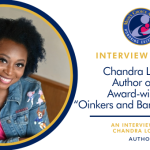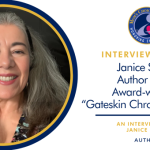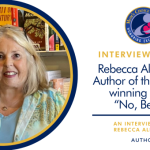Mom’s Choice Awards is excited to announce another post in our interview series where we chat with the inventors, designers, publishers, and others behind some of our favorite family-friendly products.
Hello, Mom’s Choice readers! Thanks for joining us in another interview with one of our amazing honorees! For this session, we were able to speak with Suchi Sairam, the Mom’s Choice Award-winning author of the children’s picture book Dancing Deepa. If you’d like a wonderful tool to boost your child’s pride in their native cultural traditions—or want them to feel greater self-assurance about sharing what they love, even if it’s different—this inspiring tale can help children feel proud of their cultural roots and confident in sharing them with new friends.
MCA: Suchi, we’re so glad you can speak with us today. Please start things off by telling us about yourself.
Suchi: I immigrated from India to the United States as a baby with my parents. Formative years growing up in Texas in the 1970s and ‘80s, college years in Massachusetts, adult years in Texas and Minnesota, deep familial and cultural roots in India, and international travel shape my worldview and values.
I am multi-passionate, chronically curious, and an accidental author. The arts, specifically dance, and music, have been my life’s breath for decades. Alongside my artistic journey, I’ve had almost three decades of professional experience in several areas, including engineering, marketing, product development, executive leadership and entrepreneurial ventures.
I now focus my time exclusively on the arts and adjacencies. My dance studio, Kala Vandanam, celebrated its 20th anniversary in 2022. Sharing classical Bharatanatyam dance with my students is one of my greatest joys. Continuing to learn dance and music fuels me. I love sharing the beauty of dance and music with audiences in intimate venues. Dialogue about the power and joy of art in our lives energizes me.
As a dance and music artist, entrepreneur and business professional with a range of diverse experiences, I enjoy drawing on different disciplines to create unique experiences. I view art as a vehicle for communication, internal reflection, and personal development.
I really enjoy being out in nature, traveling, experimenting in the kitchen, and doing textile crafts such as sewing, quilting and crocheting.
MCA: As you came to the US when you were so young, what got you interested in Indian classical dance, and when?
Suchi: I started my journey in earnest at the ripe age of 15, much later than most. My mom put me in classes when I was 7, but I disliked it so much. I just wanted to play soccer and learn tap dance at that age— perhaps in part due to just trying to be an “American” kid. In her wisdom, she let me leave it after a couple of months. I honestly think that is why it is still with me now after all these decades, rather than it becoming some distant memory.
My rekindled interest didn’t start from a place of positivity, but more of a competitive streak. I saw some girls a few years younger than me performing Bharatanatyam and I thought “I can do that better.” But it lit a fire to start again, and I’ve pursued it with passion and sincerity since.
MCA: What do you mean by becoming an “accidental author”? What was your path to becoming a writer like?
Suchi: Writing a book was never on my radar. It was not a dream or a bucket list item. It started with a casual conversation with one of my adult students in December 2021. She was lamenting the fact there were so few child-friendly books about Indian arts she could share with her then 3-year-old daughter. She was right—most of the books are translations of treatises, research texts, heavy biographies and the like.
This swirled around in my head a bit for a few weeks. I didn’t know how to write a children’s book, but I knew I could learn with the right guidance. I shared my initial draft with my dance students by the first week of February 2022 and self-published Dancing Deepa on June 1. It was a labor of love, and my students, from the youngest kids, teens and adults, were all an integral part. The youngest ones were so engaged at every step, giving feedback on illustrations, the design, even the content of my author page! I created it for them and with them.
MCA: It sounds like you had a lot of inspiration for writing Dancing Deepa. Were there other factors at work?
Suchi: Growing up, I felt I had an “American” life at school and an “Indian” life at home. I think this was a common feeling for those of who are immigrants or from immigrant families who grew up in the U.S. during the 1970s and ‘80s. While I see many positive changes for my students in their school experiences, I also see some things are unchanged. There is still hesitation when it comes to completely owning their hyphenated cultural identity amongst their school peers. I also thought about the many kids who have non-mainstream interests who may not feel they can be their whole selves with their friends. Dancing Deepa was inspired by my desire to help these kids them see themselves in a book, and to give them the confidence to share their passions with others.
MCA: How well can young readers relate to the beauty and discipline of a dance tradition they may not be familiar with?
Suchi: I think it depends in large part on their familiarity with dance in general. If they have a connection to dance, either dancing themselves or watching others, I think there will be able to appreciate there is beauty and discipline in another dance form. It may look a little different from what they are familiar with. However, the feeling dance creates will clearly resonate
MCA: That is so encouraging. At what age do kids respond to (as you put it) the idea of an intersection of art, culture and representation? Is that harder or easier to do so as we get older?
Suchi: I continue to be surprised by how beautifully young kids make this connection. They may not articulate it with the same words, but they will share things like “I saw someone doing something I like that is from my culture.” They understand the idea of seeing themselves in things around them early on. This intersection takes on a more personal and a more macro significance as we get older. Teens and adults want to see themselves and they want others to see themselves, too.
MCA: It sounds like a very worthy, lifelong goal. What are some of the key lessons found in Dancing Deepa?
Suchi: There are several key lessons in Dancing Deepa, along with a bonus takeaway.
First, I hope readers see how we easily create assumptions in our minds. Where do they come from? Are those assumptions even accurate? Where do they lead us?
Secondly, what does risk-taking look like? Do we equally weigh the pros and cons, or do we automatically give more weight to one or the other?
A final key lesson centers on how we show up for other people. Do we notice when others may need help? Do we reach out? Are we willing to be vulnerable and ask for the help we need?
As a bonus takeaway, I would like readers to see that there is great value in showing up as your whole self. You benefit, and those around you benefit.
MCA: What kind of response have you received from readers?
Suchi: It has been an absolute joy to hear from children, parents and teachers after they’ve read Dancing Deepa.
Kids and teens who practice Bharatanatyam share that they finally see themselves and their own doubts in a book. In fact, many of these dancer-readers have shared, “I had a Dancing Deepa moment at school.” The fact that this book has been so meaningful to teens and young adults is incredibly gratifying.
Many young readers have shared that they feel more confident sharing their non-mainstream interests with schoolmates after reading the book. Parents have shared that Dancing Deepa has become a regular bedtime story, which is any children’s book author’s dream! Teachers have shared that the book has given a pathway for discussion and for students to learn and share about each other’s interests.
Each piece of feedback solidifies for me that there is a need and place for books like this.
MCA: How would you advocate that people integrate a passion for art with their other interests and passions? And why is this so important?
Suchi: Art gives light to personal expression, communication, storytelling and community building like nothing else.
Regardless of the medium, art requires the engagement of your preferences, mind, body and values. The life lessons taught through the arts, such as lifelong learning, exploration, experimentation, perseverance, self-reflection, and cultivating growth over achievement are everlasting. Most importantly, there is no wrong way to engage with art.
Marry these qualities with your other interests and passions, and you have the ability and tools to look at anything in front of you through different lenses. This perspective uniquely positions you for meaningful contribution, personal satisfaction, and success.
MCA: What a profound statement—there’s no wrong way to engage with art. If you could ensure that readers of your book walk away with one main lesson, what would it be?
Suchi: As I tell my students: My greatest wish for you is to show up in the world as your full self—every day, all the time. The world needs ALL of your passion, talents, and point of view!
MCA: What a wonderful thought to leave our readers with. Thanks so much for being with us today!
You can learn more about Suchi Sairam and his award-winning book, Dancing Deepa, by visiting her MCA Shop page.






